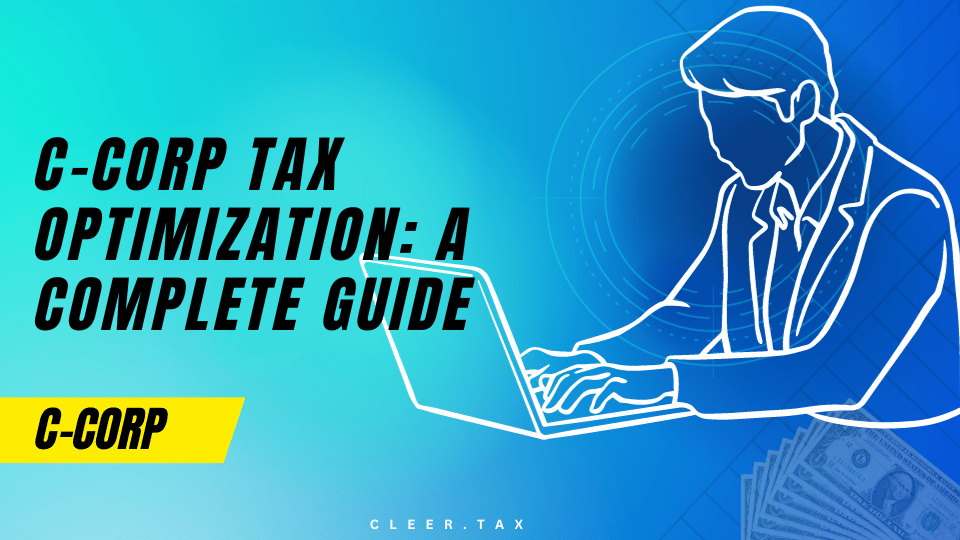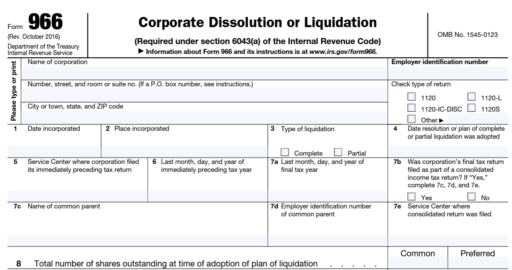Before learning about how to navigate C-corp taxation, you must understand the definition of what a corporation is, and what exactly makes it a C-corp.
What is a Corporation?
A corporation is a legal business entity that is formed in accordance with state law by filing articles of incorporation with the secretary of state’s office in the state where it is being organized. It is recognized as an artificial person with a legal identity separate and distinct from its shareholders, operating independently and taxed separately from them. Upon formation, business corporations are treated as C-corporations by default for tax purposes.
Corporations are popular entities for building a company because they can raise capital quickly by selling shares of stock, provide limited liability to investors (although this also applies to LLCs), allow free transferability of interests, and retain earnings in ways that are not allowed in other types of business entities. Corporations must meet certain formalities in order to retain their status, such as adopting by-laws, issuing stock certificates to shareholders, electing a board of directors, and holding annual meetings.
What is a C-Corporation?
A C-corporation is a tax classification, not a type of business entity like an LLC or corporation. This tax classification is available to corporations and LLCs. For federal income tax purposes, C-corporations are treated as taxpaying entities separate and distinct from their shareholders. C-corporation derives its name from Subchapter C of the Internal Revenue Code, which they are taxed under. The letter “C” in C-corporation refers to Subchapter C of the IRC, which regulates corporations and shareholders.
The other federal tax classifications in the US include sole proprietorships, partnerships, LLCs, and S corporations, which are all pass-through taxation entities.
What Sets C-Corporations Apart?
C-corporations have distinguishing features that set them apart from other entities:
- C-corporations legally separate the assets and income of the corporation from those of the shareholders.
- C-corporations have no restrictions on the number of shareholders unlike other business structures such as S-corporations, which cannot have more than 100 shareholders.
- C-corporations can issue more than one class of stock.
- There are no restrictions on who can hold shares.
- Typically, C-corporations are eligible for additional tax deductions that S-corporations and LLCs are not.
C-Corporation Taxation Explained
C-corporations offer a plethora of benefits to business owners, which is why the majority of our clients choose C-Corp status. Understanding the complexities of C-Corp taxation can help you unlock tax-saving opportunities and facilitate a smoother tax season for your business. The advantages of C-Corp taxation include greater deductions for business expenses, the ability to carry forward early-stage losses, and flexibility regarding the amount and timing of the distribution of corporate income in the form of dividends to the shareholders.
Nonetheless, it’s crucial to be mindful of the unique challenge of double taxation, in which income is taxed twice: first at the corporate level and then again when dividends are distributed. By understanding the intricacies of C-corp taxation, you will be able to make informed decisions to optimize your tax position and enhance financial efficiency. C-Corps separate the corporation’s assets and income from those of its shareholders.
C-Corporations Taxation: The Basics
When it comes to C-Corp taxation, the legal separation of corporate versus shareholder income plays a significant role. A C-Corp, which is treated as a separate legal “person” under the law, must file and pay taxes at the corporate level. Then, shareholders pay taxes on any dividends received from C-corporations. Although there is no legal requirement to pay out dividends, there may be tax-related requirements to distribute retained earnings or face higher taxation. Accumulated earnings tax (AET) can be levied if the IRS identifies that a C-corporation is withholding dividends and accumulating earnings beyond the reasonable needs of the business. The AET rate is 20%, and this is in addition to regular corporate income tax.
How is C-Corp Taxation Different from Pass-Through Entity Taxation?
The primary distinction between the two is that a C-corporation must pay income tax at the corporate level, whereas pass-through entities are exempt from paying income tax at the entity level. Pass-through entities avoid double taxation as business earnings are only taxed once, on the owner’s personal tax return. All net income passes directly to the shareholders and is taxed annually, regardless of the amount actually received by the shareholders.
How are Net Operating Losses (NOLs) and Capital Losses Treated by C-Corporations in Comparison to Pass-Through Entities?
C-corporations can claim a deduction for net operating losses (NOLs) at the entity level, whereas pass-through entities cannot. Unlike S-corporations and LLCs, C-corporations are not pass-through entities, so shareholders cannot benefit from a company’s loss. S-corporations and LLCs, on the other hand, pass through the entity’s losses to the shareholders or partners, who then deduct a portion of the losses on their personal tax returns.
Because of the characteristics of a pass-through entity, losses are often more beneficial to individuals when operating as an S-Corp or LLC for tax purposes. For C-Corps, losses can only be deducted by the company as net operating loss carryovers and cannot be taken by the individual shareholders unless the company is closed, and only then as a capital loss subject to limitations on other income that this can be deducted against.
A C-corporation may deduct its capital losses only to the extent of capital gains. It also cannot offset a capital loss against ordinary income. In general, the C-corporation’s net capital losses may be carried back three years and carried forward five years to offset capital gains. A C-corporation may carry back a capital loss to the extent that it does not increase or produce a net operating loss in the tax year it applies to.
In contrast, pass-through entities do not take into account capital gains and losses in figuring their total income to allow owners to apply the capital gain and loss rules on individual returns. This is favorable to the owners, as they can offset pass-through gains or losses against their personal gains and losses when they file their tax returns,
The Concept of Double Taxation
Double taxation is a tax principle in which the same source of income is taxed twice. Double taxation, as it relates to C-Corps, refers to the taxation of a corporation’s income twice: once at the corporate level and again at the individual level. First, C-corporations are taxed on their income at the current flat rate of 21%. This income is calculated after all losses, credits, and deductions, including shareholders’ salaries, have been taken into account. When income splitting is properly managed, we frequently see clients with better overall tax situations, which translates to lower taxes despite double taxation.
If profits are subsequently distributed to shareholders as dividends, they must pay taxes on those distributions at their individual rates, but typically at reduced qualified dividend rates of 0%, 15%, or 20%, depending on the individual’s filing status and tax rate on other income. Foreign owners of U.S. corporations are taxed on dividends at 30% unless they are residents of a country with a tax treaty that reduces this rate.
Tax Rates for C-Corporations
C-corporations are subject to taxation at both the state and federal levels. The federal corporate tax rate was reduced from 35% to a flat rate of 21% in 2018, thanks to the Tax Cuts and Jobs Act (TCJA). This 21% corporate tax rate applies to US companies’ worldwide earnings and is calculated on an annual basis after offsetting all the allowable losses, credits, and deductions.
State tax rates differ from state to state. State corporate income tax rates on income earned in 2023 range from 0% to 11.5% but are only due in states that the company is physically operating in or otherwise meets state tax requirements. However, some states, like Wyoming and Ohio, do not levy a corporate income tax. Double-check with your specific state to see what your corporate tax rate is.
C-Corporations Tax Deductions and Credits
The availability of tax deductions is one of the most advantageous aspects of C-Corp taxation. C-Corps can deduct a wide range of business expenses that are unavailable to other types of business entities, including:
- Salaries and bonuses: Full-time employee salaries, bonuses, and commission payments, as well as C-Corps’ share of payroll taxes, including reasonable salaries paid to shareholders, are all deductible. C-Corps can leverage these deductions to reduce their taxable income while still providing value to shareholders.
- Medical insurance premiums and other fringe benefits: C-Corps are permitted to deduct employee benefits, in contrast to pass-through entities, which must report fringe benefits as income. This includes healthcare plans, disability insurance, 401(k) contributions, vacation and sick leave, education and training costs, and more.
- Charitable contributions: C-Corps are the only business entities permitted to deduct charitable donations. C-Corps may deduct charitable contributions up to 10% of their taxable income in a given year and may carry forward excess contributions over the limit for up to five years.
- Business losses carried over multiple years: C-Corps can use losses to offset their tax liabilities in the current year and carry forward losses indefinitely to lower future tax obligations. However, startups should be cautious since the IRS tends to scrutinize new businesses that show losses for several years in a row under the hobby-loss rules.
- Foreign derived intangible income discount (FDII): C-Corps are the only entity type permitted to take advantage of the FDII discount on the sale of numerous goods and services to customers outside the US. The FDII discount reduces the effective tax rate by ⅓, effectively reducing the current tax rate to 13.125%.
- Global intangible low-taxed income discount (GILTI): C-Corps can also take advantage of GILTI tax discounts of 50% on income received from subsidiaries. This reduces the effective maximum tax rate for income earned through a subsidiary to 10.5%.
In addition, C-Corps may be eligible for numerous tax credits, such as the R&D credit, general business credit, and foreign tax credit. We can assist you in ensuring that you are taking advantage of all available deductions and credits.
Navigating C-Corp Taxation Requirements
In addition to filing an annual corporate tax return, C-Corps, like all businesses, must file additional forms to meet the requirements for quarterly income tax payments and employee tax withholdings. C-Corps may also be required to file tax returns in the states where they do business.
Federal Income Tax Forms
Form 1120, U.S. Corporation Income Tax Return
C-Corps are required to file federal tax returns annually, even if they have no income, turnover, or expenses. Form 1120 is the tax form used by C-corporations when filing their federal income taxes. C-Corps use Form 1120 to report gains and losses, claim credits and deductions, and compute taxes or refunds owed.
Form 1120-W, Estimated Tax for Corporations
Due to the United States’ “pay as you go” tax system, corporations must make estimated payments throughout the year as they earn income. C-Corps that anticipate owing more than $500 in taxes must make quarterly estimated tax payments using Form 1120-W. Similar to individuals, there is no exemption for the first year of owing tax, like for individuals, and if estimated taxes are not paid, an estimated tax penalty will be applied, which is the equivalent of interest accrued on the payments that should have been made. A C-corporation’s estimated taxes can only be paid using EFTPS.
Form 941, Employer’s Quarterly Federal Tax Return
C-Corps use Form 941 to report the federal, Social Security, and Medicare taxes withheld from each employee’s salary and the corporation’s contributions. Employers who pay wages must file Form 941 quarterly. Typically, Form 941 is due on the last day of the month following the end of the quarter. For example, for the wages paid from January to March, Form 941 must be filed by April 30th.
State Tax Forms
In addition to paying taxes to the Federal Government, many C-corporations are required to file state tax returns. While not all states levy corporate income tax, those that do have their own tax forms that C-corporations must use to file income taxes. See our state income tax guide for more information.
For instance, C-Corps in Delaware file their annual income tax returns using Form 1120. Meanwhile, C-Corps in North Carolina are required to file Form CD-405 to report and pay annual income taxes. Many taxpayers do not realize that Florida has a corporate income tax as they have no individual income tax, but Florida’s corporate tax form is called F-1120.
Filing Deadlines
Key tax deadlines for C-Corporations include:
- Form 1120: April 15th
- Form 1120-W: April 15th, June 15th, September 15th, and December 15th
- Form 941: April 30th, July 30th, October 31st, and January 31st
Navigating State-Specific C-Corp Taxation
C-corp taxation varies by state, so it is essential to review the laws and requirements where your company does business. To complicate matters, no two states have the same filing thresholds, and some C-corporations must file tax returns in multiple states.
Where your corporation needs to file depends on your state income tax nexus. Nexus in the context of taxes refers to the point of connection where a taxpayer meets the requirement to pay taxes.
Unfortunately, each state has its own definition of nexus. This lack of standardization makes navigating state income taxes complex for C-Corporations and their leaders. Often, companies operating in multiple states must file several state tax returns, and some earnings may even be subject to double taxation.
Thankfully, establishing nexus doesn’t necessarily mean that a C-corporation must pay state taxes on 100% of its income. Typically, corporations are only required to pay taxes based on the amount of business activity conducted within state borders.
Additionally, there are some places where C-corporations can avoid state income tax requirements altogether. The following states do not levy corporate taxes:
- Nevada *
- Ohio *
- Texas**
- South Dakota ***
- Wyoming ***
* Nevada and Ohio impose gross receipt taxes instead of corporate income taxes.
** Texas has a franchise fee calculated on corporate assets.
*** South Dakota and Wyoming are the only states without corporate income tax and gross receipts tax.
Strategies for Minimizing C-Corporation Tax Liability
Fortunately, C-corps have several means of lowering their tax liabilities and mitigating the impact of double taxation. Popular strategies for reducing C-corporation tax liability include:
- Tax Credits: C-corps can reduce their tax liabilities by dollar-for-dollar using tax credits such as the R&D credit, general business credit, and foreign tax credit. The U.S. government frequently offers tax credits as incentives for corporations to invest in areas of public interest, such as alternative energy sources, employment initiatives, and more.
- Tax Deductions: C-corporations can deduct a wider range of business expenses than other business entities. This list includes charitable contributions, salaries, bonuses, and fringe benefits for employees.
- Accelerated Depreciation: Accelerated depreciation allows C-corporations to deduct a larger percentage of an asset’s value in the early years of the investment. With proper tax planning, this tactic can help C-corporations reduce their tax bills over a number of years.
- Salary Distributions: Since salary, bonuses, and other fringe benefits are tax deductible, distributing income as compensation rather than dividends can help reduce C-corporation taxation while still delivering value in terms of company growth to business owners employed at the company.
- Deduct Business Losses: Losses can be deducted in the current year if tax is available to be offset or carried forward indefinitely to offset future tax bills for the C-corporation. Especially for startups, it can be advantageous to deduct business losses to reduce tax liability in future years when the business becomes profitable for the first time, as this can stimulate growth.
- Income Splitting: Income splitting refers to the method by which C-corporations and their owners can share earnings to keep the company and its shareholders in lower income tax brackets. Although this strategy does not eliminate double taxation, it can reduce the tax burden at both the corporate and individual levels, resulting in a lower overall tax bill than with a pass-through entity such as LLC or S-corporation.
How Can Cleer Tax Help You Simplify C-Corp Taxation?
Navigating C-Corp taxation is a complex undertaking. However, proper tax planning can help reduce the corporation’s and its owners’ tax liabilities. The team of expert accountants at Cleer Tax specializes in guiding C-corporations through the tax filing process, thereby ensuring the best possible financial outcome. Working with experts and staying ahead of important tax deadlines is essential for putting your C-Corp on the Cleer path to success.
Cleer offers consultations to discuss the best strategy for your startup C-Corp. In addition, we offer two new company packages that include tax consultation, bookkeeping software setup, and chart of accounts setup to help you get started on the right foot. We also provide 1120 Federal Income Tax Preparation, which includes your state taxes. For your convenience and optimal tax advantage, you can subscribe to our all-in-one monthly accounting packages that include monthly statements, plus your federal and state tax returns.
If you have additional questions or need further assistance, don’t hesitate to contact us. Cleer Tax is here to guide your business growth from launch to success.
Frequently Asked Questions
How does C-Corp Taxation Differ From Other Business Structures?
C-Corps need to pay taxes at the corporate level first, then again when shareholders receive dividends. Other business structures, such as S-corporations and LLCs, function as pass-through entities, passing pre-tax income to shareholders to report on their individual tax returns. In other words, the income of a C-corporation is subject to double taxation, while pass-through entities are not.
What are the Advantages and Disadvantages of C-Corp Taxation?
Advantages of C-Corp taxation include the ability to deduct a broader range of business expenses, carry forward losses, and split profits and losses between the corporation and its owners. The main disadvantage of C-Corp taxation is the double taxation that occurs when the same income is taxed first at the corporate level and then again when shareholders receive dividends.
How Can C-Corporations Minimize Their Tax Liabilities?
Some of the popular strategies for reducing C-Corp tax liability include tax credits, tax deductions, accelerated depreciation, salary distributions, deducting business losses, and income splitting.
What Happens if a C-Corporation Fails to File Its Tax Return or Pay Taxes on Time?
If a C-corporation fails to file its tax return by the due date, it incurs a late filing penalty unless it can demonstrate that the failure was due to a reasonable cause. A C-corporation that fails to file on time may owe the IRS a late filing penalty equal to 5% of the amount of unpaid tax for each month (or fraction of a month) that taxes remain unpaid, up to a maximum of 25% of the unpaid tax. For returns required to be filed in 2023 that are over 60 days late, the minimum Failure to File Penalty is $450 or 100% of the tax due as shown on the return, whichever is less.
In addition, if it fails to pay the amount shown in the return, a Failure to Pay Penalty of ½ of 1% or .5% is assessed on the amount of unpaid tax for each month or portion of a month that the tax remains unpaid.
Let Cleer Tax Guide the Way through the Complexities of C Corp Taxation
As you may have picked up from this article, C Corp taxation is complex and, oftentimes, confusing. Allow Cleer Tax to guide your way so you can get your taxes filed on time and avoid penalties for making honest mistakes. Our team of experts makes managing tax filing for C-corporations easier than ever.






